USS Tautog (SSN-639)
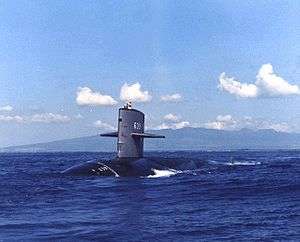 USS Tautog (SSN-639) off the Hawaiian Islands. | |
| History | |
|---|---|
| Name: | USS Tautog (SSN-639) |
| Namesake: | The tautog, a type of wrasse. |
| Ordered: | 30 November 1961 |
| Builder: | Ingalls Shipbuilding, Pascagoula, Mississippi |
| Laid down: | 27 January 1964 |
| Launched: | 15 April 1967 |
| Sponsored by: | Pauline Lafon Gore |
| Commissioned: | 17 August 1968 |
| Decommissioned: | 31 March 1997 |
| Struck: | 31 March 1997 |
| Motto: | Silent Vigilance |
| Nickname(s): | "The Terrible T" |
| Fate: | Scrapping via Ship and Submarine Recycling Program completed 30 November 2004 |
| Status: | Recycled |
| Badge: |
|
| General characteristics | |
| Class and type: | Sturgeon-class attack submarine |
| Displacement: |
|
| Length: | 89 m (292 ft) |
| Beam: | 9.7 m (32 ft) |
| Draft: | 8.8 m (29 ft) |
| Propulsion: | S5W nuclear reactor |
| Speed: | >20kt |
| Test depth: | >400ft |
| Complement: |
|
USS Tautog (SSN-639), a Sturgeon-class attack submarine, was the second ship of the United States Navy to be named for the Tautog (Tautoga Onitis), a wrasse commonly found along the Northern Atlantic coast. The submarine was in service from 17 August 1968 to 31 March 1997.
Construction and commissioning

The contract to build Tautog was awarded to Ingalls Shipbuilding in Pascagoula, Mississippi, on 30 November 1961 and her keel was laid down there on 27 January 1964. She was commissioned on 15 March 1967, sponsored by Pauline Lafon Gore, wife of United States Senator Albert Gore, Sr. (1907–1998) of Tennessee.[1] Under sunny skies, a crowd of thousands watched as Mrs. Gore took a hearty swing with a bottle of champagne and intoned the memorial words, "In the name of the United States of America, I christen thee Tautog." Tautog was commissioned 17 August 1968 under the command of Commander Buele G. Balderston.[1]
Service history
1968–1970
On 30 August 1968, Tautog departed Pascagoula on her way to join the United States Pacific Fleet. She transited the Panama Canal on 8 September 1968 and arrived at Pearl Harbor, Hawaii, on 23 September 1968. There, she joined Submarine Squadron 12, serving as its flagship. Throughout 1969, Tautog completed her post-commissioning tests and sea trials, followed by her shakedown training cruise. She conducted the majority of these operations in the vicinity of the Hawaiian Islands, although in January and February 1969 she berthed in Puget Sound Naval Shipyard at Bremerton, Washington, for trials and repairs. She completed her shakedown training in September 1969 and, on 15 September 1969, began post-shakedown repairs and alterations which were protracted by the necessity of replacing her entire diesel generator. Tautog's repairs finally were completed on 19 February 1970, and she began normal operations out of Pearl Harbor, involving torpedo and sonar tracking exercises,[1] culminating in Tautog earning the Battle Efficiency "E" in 1970 for outstanding performance.[2] Tautog received a Navy Unit Commendation for service on or about 1 June 1969.[3] According to Drew, 2008, Tautog monitored a test of new cruise missiles launched from an Echo II class Soviet submarine in the summer of 1969.[4]
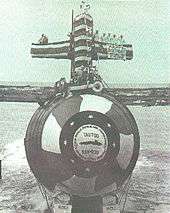
Tautog sailed with the Seventh Fleet (Western Pacific, or WESTPAC) in 1970, making port calls in the Philippines, Hong Kong, Okinawa, Japan and Korea.[1] Upon return to Pearl Harbor, Tautog was presented the Meritorious Unit Commendation for operations conducted during that deployment, 1 October 1970 to 1 April 1971.[3]
Collision with K-108, 1970
On 20 June 1970, Tautog was patrolling the North Pacific Ocean near the city of Petropavlovsk-Kamchatsky, on the Soviet Union's Kamchatka Peninsula, which was a major base for missile-armed submarines of the Soviet Navy. Tautog was attempting to trail the K-108, a Soviet Navy Echo II-class guided missile submarine nicknamed "Black Lila". The Soviet submarine was "close aboard" with Tautog, unaware that Tautog was in the vicinity, and the two submarines were within feet of one another for a lengthy period. Unable to determine the depth of the K-108, as new depth-finding hydrophones had not yet been installed, the American submarine was at a disadvantage in such close quarters. At some points the hydrographic equipment aboard Tautog registered zero distance between the submarines. At another point "Tautog's" hydrophone operators assumed the K-108 had risen to near the surface, placing the Soviet submarine directly above Tautog. Then the operators determined the Soviet vessel was descending. The trace on the oscilloscope, that gave the American submariners at visual reference as to the distance of the K-108, disappeared. Just as the captain began to say the Soviet sub was coming close aboard again, K-108 slammed belly first into the top of the Tautog's sail, proof the Soviet vessel had been descending from directly above. The K-108's massive screws came into contact with the steel of the Tautog's sail and lost one screw. This was confirmed by hydrographic sound of a turbine running away aboard the Soviet sub, being no longer coupled to a propeller.[5]Tautog suffered damage to her sail. As Tautog proceeded away from the site of the accident, her crew heard what they believed was K-108 breaking up and sinking.[6] When Tautog arrived in Pearl Harbor, a large portion of one of K-108's screws was found embedded in her sail. Over thirty years later, after the collapse of the Soviet Union, it was revealed that K-108 had actually been able to return to Petropavlovsk-Kamchatsky. The former captain of the K-108, Boris Bogdasaryan, was able to provide a concise narrative of the collision. The collision resulted in no casualties aboard either submarine.

Even though the occurrence of this event was adamantly denied by the United States and the Soviet Union, the Tautog's sail was permanently bent at a 2° angle, which made dry-docking problematic.
In 1991, the Chicago Tribune broke the story about the collision. Discovery Channel mentioned it in their TV program Sharks of Steel, and the full details were finally made public in 1999 in the book Blind Man's Bluff: The Untold Story Of American Submarine Espionage.[4]
1970–1977
On 9 October 1970, Tautog departed Pearl Harbor for her first East Asian deployment. She arrived on station at Buckner Bay, Okinawa, on 23 October 1970 and joined the United States Seventh Fleet. During her tour of duty in the Western Pacific, she was completely engaged in antisubmarine warfare training, usually with units of the Seventh Fleet but, on one occasion, in a joint operation with the British Royal Navy frigate HMS Aurora (F10). She spent time in port for liberty and repairs at such places as U.S. Naval Base Subic Bay in the Philippines; Hong Kong; Yokosuka, Japan; and the South Korean port of Pusan. She concluded her first tour of duty in the Western Pacific on 28 March 1971 when she departed Yokosuka bound for Hawaii. She arrived at Pearl Harbor on 5 April 1971 and resumed her routine of upkeep in port alternated with periods at sea engaged in antisubmarine warfare training for the remainder of 1971 and during the first three months of 1972.[1]
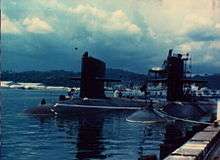
On 21 March 1972, Tautog put to sea for a special operation. During that mission, she called briefly at Guam and at Subic Bay. At the conclusion of the assignment, Tautog earned the Navy Unit Commendation for operations conducted during that deployment, 1 June 1972.[3] Tautog made a liberty visit to Hong Kong before returning via Guam to Pearl Harbor, where she arrived on 31 August 1972. She conducted operations in the Hawaiian Islands for the remainder of 1972.[1]
On 15 January 1973, Tautog entered the Pearl Harbor Naval Shipyard for her first regular overhaul. It was completed on 15 April 1974, when she resumed local operations out of Pearl Harbor which – except for a voyage to the Pacific Northwest which lasted from late July to early September 1974 – occupied her time until the beginning of May 1975. On 3 May 1975, she departed Pearl Harbor for another series of special operations in the Central Pacific and Western Pacific. That voyage included a period in drydock at Guam during the first week in June 1975 as well as exercises in the Philippines near Subic Bay. Ports of call once again included Subic Bay and Hong Kong but no South Korean or Japanese ports. Tautog returned to Pearl Harbor on 18 October 1975 and resumed her schedule of training and upkeep. The officers and crew were awarded the Navy Expeditionary Medal for the successful completion of their assigned mission.
1977–1980
Attack submarine training, independent ship's exercises, inspections, and evaluations, all conducted in the Hawaiian Islands operating area, consumed Tautog's energies through the end of 1976. She did not deploy overseas again until the beginning of 1977, when she got underway for a goodwill visit to Mombasa, Kenya. Departing Pearl Harbor on 3 January 1977, she reached Mombasa on 24 January 1977 and remained there for a month while her crew saw the sights and she received visitors on board.[1][7]
Uganda crisis, 1977
Tautog departed Mombasa on 24 February 1977 and started east toward Pearl Harbor. On the way, however, President of Uganda Idi Amin had precipitated a crisis by rounding up all Americans resident in Uganda in response to President of the United States Jimmy Carter's condemnation of the murders of two of Amin's Ugandan political opponents, and Tautog received orders to join a hastily organized task force built around the nuclear-powered aircraft carrier USS Enterprise (CVN-65) and return to the East African coast.[8] While the United States waited for Amin to make his mind up about whether or not to release the American hostages, Tautog cruised the coast of Kenya, which stands between landlocked Uganda and the Indian Ocean, with the Enterprise task force both as a show of American resolve to protect U.S. citizens in Uganda and as a scratch force to try for a hostage rescue if one became necessary.[1] Tautog received a Meritorious Unit Commendation for service 1 November 1976 to 5 July 1977.[3]

Amin eventually freed the hostages, and Tautog was released from the special task force and resumed her voyage east, arriving at Guam on 19 March 1977. Tautog visited Chinhae, South Korea, in April and, on 20 April 1977, arrived in Subic Bay for a series of special operations in the Philippines.[1]
Early in May 1977, Tautog made a liberty call at Hong Kong and then returned to Subic Bay on the 18 May.[1] Special operations occupied her time in late May and in June. On 3 July 1977, she arrived back at Pearl Harbor[1] and began a customary post-deployment standdown to allow the crew to rest and recuperate.
During the 1977 WESTPAC deployment, her crew enjoyed such liberty ports as Mombasa (Kenya), Guam, Chin Hae (South Korea), the Philippines, and Hong Kong. Upon return to Pearl Harbor, preparations were made for the transit to Vallejo, California, where Tautog would undergo its second major overhaul and receive a new reactor core. In December 1977 Tautog entered Mare Island Naval Shipyard and the overhaul commenced.
Following completion of the standdown on 8 August 1977, Tautog conducted local operations in the Hawaiian area until she departed Pearl Harbor on 2 December 1977 to proceed to the Mare Island Naval Shipyard at Vallejo, California, for an overhaul. This overhaul, which included the refueling of her nuclear core, lasted nearly fifteen months, after which Tautog successfully completed her sea trials and sailed to Pearl Harbor to rejoin the Submarine Force arriving in July 1979.
1980–1997
Following an intense period of training and operational exercises, Tautog again deployed on WESTPAC in March 1980. Tautog met every commitment placed on her during this period of international tension, and was awarded the Navy Expeditionary Medal[3] for her performance. In September 1980, the ship was awarded the Battle Efficiency "E",[3] Anti Submarine Warfare "A" and Engineering "E" for excellence displayed during the previous year. Port visits to Diego Garcia; the Philippines; Perth, Australia; and Guam were enjoyed by all hands. Tautog also received a Meritorious Unit Commendation for service on or around 1 June 1980.[3]

1981 found the ship and crew rested and ready to go. After a vigorous training cycle, Tautog sailed west once more in support of the Seventh Fleet in the Pacific and Indian Oceans. She became the first nuclear submarine to transit the Malacca Straits, surfaced and visited Singapore, the Philippines, Australia, Diego Garcia and Japan. Later in 1982 Tautog earned her third consecutive Engineering "E" and a Damage Control "DC" for excellence in Engineering and Damage Control.
In winter 1982, Tautog joined one of her sister ships, the USS Aspro, and journeyed to the frozen reaches of the North.[9] She operated beneath the ice pack for two months and conducted a dual surfacing maneuver at the North Pole with USS Aspro. It was said to be the second rendezvous by two U.S. submarines at the pole and the first during winter.[10]
During summer 1983, Tautog once again found herself operating under the Arctic ice pack. To celebrate her arrival at the Pole, the crew had a picnic, a tug-of-war and dog sled races "around the world".

In 1984, following a two-month shipyard availability, Tautog entered a vigorous operational crew training period. In the spring of 1984, Tautog again journeyed west in support of Seventh Fleet operations. Tautog operated extensively in the Northern Pacific, making port visits to the Philippines, Thailand, and Japan. Again, Tautog was awarded the Navy Expeditionary Medal.
Tautog completed a Western Pacific deployment in November 1984 upon her return to Pearl Harbor. After completing a standdown and a post-deployment upkeep period, she hosted prospective commanding officer operations in February 1985 and spent a three-day liberty period at Lahaina, Hawaii, on Maui.
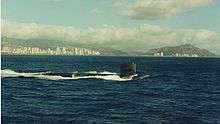
In the summer of 1985 Tautog joined the attack submarine USS New York City (SSN-696) in hosting prospective commanding officer operations.
In October 1985, Tautog left Pearl Harbor for a Western Pacific and Indian Ocean deployment, visiting Guam; Singapore (for Christmas); Diego Garcia twice; Perth, Australia; the Philippines; and Chinhae, South Korea. On her return to Pearl Harbor Tautog picked up an Operational Reactor Safeguard Examination team.
During the Tautog's time in Subic Bay, Ferdinand Marcos was deposed as President of the Philippines and Corazon Aquino was declared the new president. Tautog finished its refit and continued on to finish its WestPac.
Once back in Pearl Harbor in April 1986, Tautog had a change of command ceremony in which Commander Walter P. Stuermann relieved Commander T. R. Kent as commanding officer.
In October 1986, Tautog began a non-refueling overhaul at Puget Sound Naval Shipyard, Bremerton, Washington. After extensive modifications and testing, Tautog returned to her homeport of Pearl Harbor, Hawaii on 30 May 1989.
Tautog departed on her eighth Western Pacific deployment in May 1990 visiting Singapore, Hong Kong, Subic Bay (Philippines), and Yokosuka, Japan. The ship experienced a massive typhoon which prevented her from entering Subic Bay for almost a week.
Back in Pearl Harbor in November 1990, Tautog enjoyed the holidays and began preparing for her third arctic deployment. In April 1991 Tautog once again joined her sister ship, the USS Asprofor three weeks of Arctic under-ice operations, ending in a liberty port in San Francisco. After the exercise, Tautog performed an emergency main ballast tank blow from her test depth.
In summer 1991, Tautog hosted the JMSDF submarine Akishio on her mid-Pac cruise. Several members of both crews shared in each other's culture, and some former members of each crew are still in contact.
During the 50th-anniversary remembrance observances of 7 December 1941 attack on Pearl Harbor by the Japanese Empire, Tautog held the honor of being the showcase submarine, hosting many distinguished World War II veterans.
In late January 1992, Tautog successfully fired a MK 48 Advanced Capability warshot torpedo and laid the diesel submarine ex-Darter to rest in the deep waters just south of Oahu.

In summer 1992, Tautog set sail on a WESTPAC deployment where she pulled back-to-back operations totaling approximately 150 days at sea of the approximate 180-day deployment.
In October 1993, Tautog was sent on an emergent WESTPAC with four days notice. The ship and crew participated in a joint exercise with the Japanese Maritime Self Defense Force, then enjoyed a liberty port in Hong Kong.
In February 1995, Tautog departed Pearl Harbor for her eleventh WESTPAC deployment conducting joint operations with Japanese, Korean and British naval forces. During this deployment the crew was still able to enjoy such liberty ports as Guam, Hong Kong, Yokosuka (Japan), Sasebo (Japan), Okinawa (Japan), Chinhae (South Korea), and Subic Bay (Philippines). Tautog was awarded the Navy Expeditionary Medal for the highly successful completion of this cruise.
Misfortune arrived in February 1996 while the Tautog was conducting a personnel transfer in the mouth of Pearl Harbor. Unusual winds blowing from Maui caught the sail and Tautog drifted off course. While the Officer of the Deck was trying to reposition her, she ran into the west bank of the harbor. The damage was slight – cracking the sonar dome – but it was still a ship grounding incident and a board of inquiry was launched to determine the root cause of the incident.
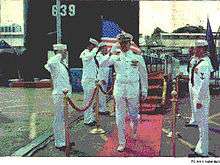
In July 1996, Tautog departed on her final deployment, this time to the eastern Pacific, supporting weapons testing and weeks of daily Midshipman orientation cruises. Liberty ports included San Diego and Esquimalt (British Columbia), with a repair stop in Bangor, Washington.
Tautog made her last dive on Sunday, 13 October 1996, her 1119th dive.
Tautog's inactivation ceremony was held on 25 October 1996. After an inactivation period of approximately 6 months, Tautog departed her lifelong homeport of Pearl Harbor, Hawaii for the final time, en route to Puget Sound Naval Shipyard for final disposition.
Decommissioning and disposal
Tautog was decommissioned on 31 March 1997 and stricken from the Naval Vessel Register the same day. Her scrapping via the U.S. Navy's Nuclear-Powered Ship and Submarine Recycling Program at Puget Sound Naval Shipyard in Bremerton began on 15 March 2003 and was completed on 30 November 2004.
Commemoration
Tautog's sail was preserved and is now on display at Seawolf Park in Galveston, Texas. 29°20′03″N 94°46′42″W / 29.3342°N 94.7782°WCoordinates: 29°20′03″N 94°46′42″W / 29.3342°N 94.7782°W). It suffered damage when Hurricane Ike struck the area in 2008.
 Ex-Tautog awaiting recycling in Bremerton
Ex-Tautog awaiting recycling in Bremerton
 Tautog sail awaits preparation for the memorial
Tautog sail awaits preparation for the memorial
References
- 1 2 3 4 5 6 7 8 9 10 11 "Tautog II". Dictionary of American Naval Fighting Ships. Navy Department, Naval History and Heritage Command.
- ↑ "FY 1970 Battle Efficiency Awards" (PDF). All Hands (November 1970): 40.
- 1 2 3 4 5 6 7 "Unit Awards for USS Tautog". US Navy.
- 1 2 Drew, Christopher; Sontag, Sherry (2008). "7". Blind Man's Bluff: The Untold Story Of American Submarine Espionage. PublicAffairs. p. 250. ISBN 978-1-58648-678-5.
- ↑ "Sonntag, Sherry, and Drew, Christopher, Blind Man's Bluff: The Untold Story Of American Submarine Espionage, p. 146. New York, PublicAffairs Publishers, 1998
- ↑ Atlas, Terry (19 March 1993). "Greenpeace: Russia lacks means to safely mothball nuclear subs". The Day. New London, CT. Chicago Tribune. p. B6.
- ↑ "USS Enterprise". history.navy.mil.
Attack submarines Scamp (SSN-588) and Tautog (SSN-639) "contributed greatly" to evaluations of the SH-3D, S-3A and TSC as an "ASW team".
- ↑ "USS Enterprise 1977 Command History" (PDF). April 1978. p. 6.. Details the measures taken to conduct a covert rendezvous with Enterprise.
- ↑ "Aspro II". Dictionary of American Naval Fighting Ships. Navy Department, Naval History and Heritage Command.
- ↑ Sundlin, Mel. "Rendezvous at the North Pole" (PDF). All Hands (December 1983): 20–21.
- This article incorporates text from the public domain Dictionary of American Naval Fighting Ships. The entry can be found here.
- This article includes information collected from the Naval Vessel Register, which, as a U.S. government publication, is in the public domain. The entry can be found here.
- USS Tautog SSN-639 Decommissioning Brochure
- Former usstautog.com web site (no longer available)
External links
| Wikimedia Commons has media related to USS Tautog (SSN-639). |